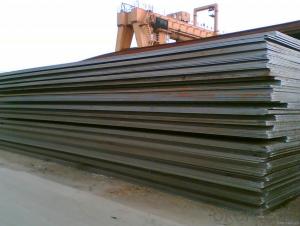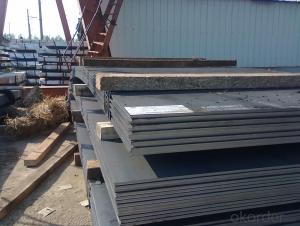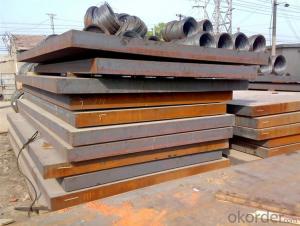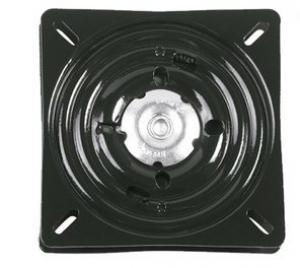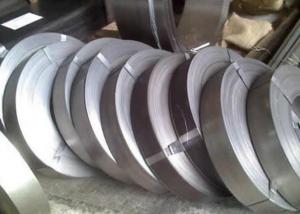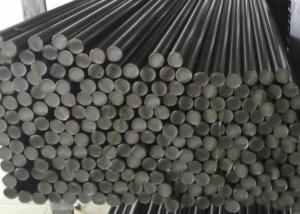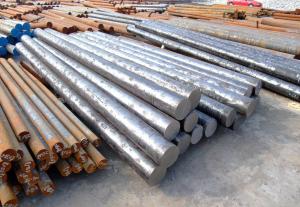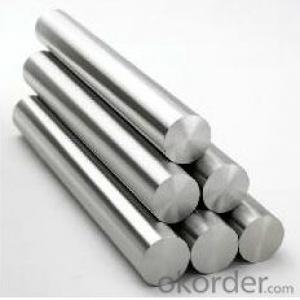Hot Rolled Mild Steel Plate JIS SS400 Carbon Steel Sheet
- Loading Port:
- China main port
- Payment Terms:
- TT or LC
- Min Order Qty:
- 25 m.t.
- Supply Capability:
- 10000 m.t./month
OKorder Service Pledge
OKorder Financial Service
You Might Also Like
Item specifice
Steel sheet, steel plate, mild steel sheet, carbon steel sheet
Size | Thickness:2.0-200mm |
Application | Steel plates are widly used as boiler plate, container plate, flange plate and ship plate, and also widly used in building construction. The size of steel plate can be made according to clients requirements. |
Packing | In bulk or as required |
| Delivery time | Within 10-25 days after order confirmed and L/C received |
Workshop Show

Shipping
1. FedEx/DHL/UPS/TNT for samples, Door-to-Door;
2. By Air or by Sea for batch goods, for FCL; Airport/ Port receiving;
3. Customers specifying freight forwarders or negotiable shipping methods!
Delivery Time: 3-7 days for samples; 5-25 days for batch goods.
Package Informations
1) EXPORT, In 20 feet (GW 25 ton) or 40 feet Container (GW 25 ton)
2)as customer's requirement
Why choose us?
(1) The leading exporter in China special steel industry.
(2) Large stocks for various sizes, fast delivery date.
(3) Good business relationship with China famous factories.
(4) More than 7 years steel exporting experience.
(5) Good after-sales service guarantee.
- Q:What are the common defects found in special steel?
- The defects commonly found in special steel may vary depending on the specific type and manufacturing process employed. However, there are a few defects that tend to be prevalent across different types of special steel. One frequently encountered defect is the presence of surface imperfections, including cracks, pits, or scratches. These imperfections can occur during manufacturing or as a result of handling and transportation. Not only do surface imperfections affect the steel's aesthetic appeal, but they can also compromise its structural integrity. Another defect commonly observed is the existence of internal voids or inclusions. These are small pockets of gas or non-metallic materials trapped within the steel during casting or forging. Internal voids can weaken the steel and make it more susceptible to failure when subjected to stress. Inconsistent composition is also a defect that can arise in special steel. This occurs when the alloying elements are not evenly distributed throughout the steel. Such inconsistency can lead to variations in mechanical properties and render the steel less reliable and predictable in terms of performance. Grain structure defects are another common occurrence in special steel. These defects arise when the grains within the steel are improperly formed or are not uniform in size. Grain structure defects can negatively impact the steel's strength and toughness, thereby increasing its susceptibility to fracture or deformation. Lastly, improper heat treatment can give rise to defects in special steel. Since heat treatment is a crucial process in steel manufacturing, any errors in its execution can result in various defects, such as excessive hardness, brittleness, or poor dimensional stability. It is important to note that while these defects are commonly found, they can be minimized or eliminated through meticulous manufacturing processes, stringent quality control measures, and appropriate handling and storage of the steel.
- Q:What are the different cutting tools used for machining special steel?
- Some different cutting tools used for machining special steel include carbide inserts, high-speed steel (HSS) end mills, diamond-coated tools, and ceramic cutting tools. These tools are designed to withstand the high hardness and heat resistance of special steels, ensuring precise and efficient cutting operations.
- Q:How is high-temperature steel used in the production of furnace components?
- High-temperature steel is used in the production of furnace components due to its exceptional heat resistance and strength. This type of steel can withstand extreme temperatures without losing its structural integrity, making it ideal for lining furnace walls, constructing heating elements, and manufacturing other critical parts that are exposed to intense heat.
- Q:What are the different surface finishing methods used for special steel?
- There are several surface finishing methods used for special steel, including electroplating, powder coating, anodizing, painting, and passivation. These methods are employed to enhance the appearance, corrosion resistance, durability, and overall performance of the steel.
- Q:What are the different coating techniques used for special steel?
- Some of the different coating techniques used for special steel include hot-dip galvanizing, electroplating, powder coating, and metallizing.
- Q:What is the maximum temperature that special steel can withstand?
- The maximum temperature that special steel can endure relies on the particular steel type employed. Special steels are engineered to possess improved qualities, including heightened resistance to heat, enabling them to endure higher temperatures in comparison to standard steels. To illustrate, certain special steels, like heat-resistant stainless steels, can withstand temperatures of approximately 1200 degrees Celsius (2200 degrees Fahrenheit). These steels are frequently utilized in scenarios where high temperatures are encountered, such as in furnaces, boilers, and exhaust systems. Different types of special steels, such as tool steels or high-speed steels, may have varying limits on their maximum temperature. These steels are commonly employed in cutting tools, molds, and machining applications, where they must maintain their hardness and strength at elevated temperatures. It should be noted that the maximum temperature that special steel can endure is also influenced by factors such as the duration of exposure to high temperature, the specific composition of the alloy, and any additional processes of heat treatment applied. Therefore, it is vital to refer to the manufacturer's specifications or seek professional advice to obtain accurate information regarding the maximum temperature limit for a specific type of special steel.
- Q:How does special steel contribute to the automotive suspension industry?
- Enhanced strength, durability, and performance are essential qualities that special steel brings to the automotive suspension industry. Suspension components greatly benefit from special steel alloys, particularly high-strength low-alloy (HSLA) steel, which are tailor-made to withstand the demanding conditions of the suspension system. This ensures optimal performance and safety. One of the primary advantages of special steel in the automotive suspension industry lies in its outstanding strength-to-weight ratio. Suspension components crafted from special steel alloys can endure heavy loads without succumbing to deformation, resulting in improved vehicle handling, stability, and overall performance. Its strength also contributes to increased durability, reducing the likelihood of premature component failure and extending the lifespan of the suspension system. Moreover, special steel offers superb fatigue resistance, a critical characteristic in the suspension industry where components experience repeated stress and vibrations. This fatigue resistance prevents the occurrence of cracks and fractures in suspension parts, guaranteeing dependable and secure operation even in challenging conditions. Additionally, special steel alloys provide superior corrosion resistance, safeguarding suspension components from the damaging effects of moisture, salt, and other environmental factors. This corrosion resistance extends the lifespan of the suspension system, decreasing maintenance costs, and enhancing overall reliability. Furthermore, special steel allows for improved design flexibility in suspension components. Its unique properties, such as high formability and weldability, enable manufacturers to create intricate and lightweight designs, resulting in more efficient suspension systems. These lightweight designs not only contribute to fuel efficiency and reduced emissions but also enhance the overall driving experience by improving vehicle agility and responsiveness. In summary, special steel plays an indispensable role in the automotive suspension industry, delivering enhanced strength, durability, and performance to suspension components. Its exceptional strength-to-weight ratio, fatigue resistance, corrosion resistance, and design flexibility contribute to improved handling, stability, safety, and overall vehicle performance. Through its unique properties, special steel ensures reliable and efficient suspension systems, satisfying the demanding requirements of the automotive industry.
- Q:How is the hardness of special steel measured?
- Various methods are typically used to measure the hardness of special steel. The most common method is the Rockwell hardness test, which involves pressing a diamond or hardened steel ball into the surface of the steel to measure the depth of penetration. The Rockwell hardness number is determined based on the difference in depth before and after the application of a minor load and a major load. Another widely used method is the Brinell hardness test, which involves indenting a hardened steel or carbide ball into the steel surface and measuring the diameter of the indentation. The hardness is calculated based on the applied load and the diameter of the impression. Additionally, for specific applications, other methods like the Vickers hardness test and the Knoop hardness test are often employed. These tests require indenting the steel surface with a diamond pyramid to measure the diagonal lengths or the indentation depth, respectively. Ultimately, the hardness of special steel is determined by assessing its resistance to indentation or penetration. This information is valuable in understanding the mechanical properties of the steel and determining its suitability for different applications.
- Q:Can special steel be used in the appliance manufacturing industry?
- Yes, special steel can be used in the appliance manufacturing industry. Special steels, such as stainless steel or high-strength steel, offer various advantages such as corrosion resistance, durability, and enhanced mechanical properties. These qualities make them suitable for manufacturing appliances that require high performance, such as refrigerators, ovens, or washing machines. Additionally, special steels can be customized to meet specific design requirements and can contribute to the overall aesthetic appeal of the appliances.
- Q:What are the challenges in manufacturing special steel?
- There are several challenges in manufacturing special steel. One of the main challenges is ensuring the precise composition and properties of the steel. Special steels often require specific alloying elements and precise heat treatments to achieve desired characteristics, making it crucial to maintain strict quality control throughout the manufacturing process. Another challenge is the high cost of raw materials and the need for advanced equipment and technology to produce special steel. Additionally, meeting stringent industry standards and regulations, as well as managing environmental impacts, can pose challenges in the manufacturing of special steel.
1. Manufacturer Overview |
|
|---|---|
| Location | |
| Year Established | |
| Annual Output Value | |
| Main Markets | |
| Company Certifications | |
2. Manufacturer Certificates |
|
|---|---|
| a) Certification Name | |
| Range | |
| Reference | |
| Validity Period | |
3. Manufacturer Capability |
|
|---|---|
| a)Trade Capacity | |
| Nearest Port | |
| Export Percentage | |
| No.of Employees in Trade Department | |
| Language Spoken: | |
| b)Factory Information | |
| Factory Size: | |
| No. of Production Lines | |
| Contract Manufacturing | |
| Product Price Range | |
Send your message to us
Hot Rolled Mild Steel Plate JIS SS400 Carbon Steel Sheet
- Loading Port:
- China main port
- Payment Terms:
- TT or LC
- Min Order Qty:
- 25 m.t.
- Supply Capability:
- 10000 m.t./month
OKorder Service Pledge
OKorder Financial Service
Similar products
New products
Hot products
Related keywords
